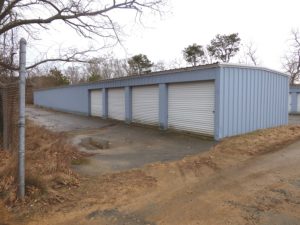EASTHAM — A proposal by Willy’s Gym owner Barbara Niggel to expand the number of storage units at 4730 State Highway has been scaled back after a Cape Cod Commission (CCC) staff report indicated that the storage pods would be considered buildings, and their proposed size would have triggered an automatic CCC review of the development.
Attorney Ben Zehnder, representing Niggel and her companies Goeroe’s Goldens LLC and Stow Away LLC, told the planning board at its July 21 public hearing that his client had assumed the storage pods were “personal property” and not buildings.
For that reason, said Zehnder, Stow Away’s project engineer, John O’Reilly of Brewster, “went back, yet again, and redesigned to remove storage pods so that the total pod area, consisting of two sections of pods, was under 10,000 square feet.”

The thresholds for triggering a Cape Cod Commission review as a development of regional impact (DRI) are 10,000 square feet for building projects and 40,000 square feet for disturbed open area.
Planning board member Jim Kivlehan pointed out the revised total area was 9,600 square feet, 400 feet short of triggering a review as a DRI.
“What do we gain as a town if we go through the Cape Cod Commission review?” Kivlehan asked. “What would happen there? You’re trying to avoid it because, I can imagine, it’s bureaucratic.”
Town Planner Paul Lagg replied that the CCC uses a different set of review criteria if the thresholds for a large project have been met. “They look at it not just through the lens of Eastham, but of the region,” said Lagg.
A 4,800-square-foot storage unit building was dropped from the plan by Niggel earlier this year after an informal poll of planning board members indicated their intention to refer the project to the Cape Cod Commission.
Zehnder commented that projects are typically engineered to come in under the DRI thresholds. “The Cape Cod Commission Act was passed in 1989,” he said. “And this 10,000-square-foot threshold — you can start in Orleans and go to P’town and count on both hands the number of projects that have been referred as mandatory DRIs.
“There’s a presumption in the Cape Cod Commission Act in the DRI threshold,” he continued, “that if you keep under 10,000 square feet of building and 40,000 square feet of open area use you don’t have any regional impact.”
Planning board member William Craig asked if Niggel, having avoided the DRI review by reducing the size of the project, might return to the board later with a plan for more storage units.
“Are we going to be nibbled to death by ducks?” asked Craig.
Zehnder replied that the Cape Cod Commission looked at segmentation and whether there was an intent to segment a proposal. “I think, in this particular case,” he said, “if the applicant were to come back and say, ‘Look, we want to add another 9,600 square feet of building on the property,’ I think it would get tagged as segmentation immediately.”
Planning board chair Dan Coppleman asked Zehnder if he would agree to a condition that would forestall segmentation.
“We have the right to come back and ask for it,” replied Zehnder.
“I didn’t say you didn’t,” responded Coppelman. “We have the right to say no — if you were segmented.”
The hearing was continued until Aug. 18. A work session was held on the project on Aug. 2.



